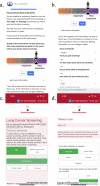The SIMPLE Architectural Pattern for Integrating Patient-Facing Apps into Clinical Workflows: Desiderata and Application for Lung Cancer Screening
- PMID: 38222334
- PMCID: PMC10785839
The SIMPLE Architectural Pattern for Integrating Patient-Facing Apps into Clinical Workflows: Desiderata and Application for Lung Cancer Screening
Abstract
In December 2022, regulations from the U.S. Office of the National Coordinator for Health IT came into effect that require electronic health record (EHR) systems to accept the connection of any patient-facing digital health app using the SMART on FHIR standard. However, little has been reported with regard to architectural patterns that can be reused to take advantage of this industry development and integrate patient-facing apps into clinical workflows. To address this need, we propose SIMPLE, short for Standards-based Implementation Maximizing Portability Leveraging the EHR. The SIMPLE architectural pattern was designed to meet several key desiderata: do not require patients to install new software; do not retain patient data outside of the EHR; leverage EHRs' existing personal health record (PHR) capabilities to optimize user experience; and maximize portability. Using this pattern, an application for lung cancer screening known as MyLungHealth has been designed and is undergoing iterative user-centered enhancement.
©2023 AMIA - All rights reserved.
Figures



Similar articles
-
Integrating a Patient Engagement App into an Electronic Health Record-Enabled Workflow Using Interoperability Standards.Appl Clin Inform. 2022 Oct;13(5):1163-1171. doi: 10.1055/s-0042-1758736. Epub 2022 Dec 14. Appl Clin Inform. 2022. PMID: 36516969 Free PMC article.
-
Opening the Duke electronic health record to apps: Implementing SMART on FHIR.Int J Med Inform. 2017 Mar;99:1-10. doi: 10.1016/j.ijmedinf.2016.12.005. Epub 2016 Dec 12. Int J Med Inform. 2017. PMID: 28118917
-
Integrating Option Grid Patient Decision Aids in the Epic Electronic Health Record: Case Study at 5 Health Systems.J Med Internet Res. 2021 May 3;23(5):e22766. doi: 10.2196/22766. J Med Internet Res. 2021. PMID: 33938806 Free PMC article.
-
Using the Electronic Health Record to Enhance Care in Pediatric Rheumatology.Rheum Dis Clin North Am. 2022 Feb;48(1):245-258. doi: 10.1016/j.rdc.2021.08.004. Rheum Dis Clin North Am. 2022. PMID: 34798950 Review.
-
The Integral Role of the Electronic Health Record and Tracking Software in the Implementation of Lung Cancer Screening-A Call to Action to Developers: A White Paper From the National Lung Cancer Roundtable.Chest. 2020 Jun;157(6):1674-1679. doi: 10.1016/j.chest.2019.12.004. Epub 2019 Dec 23. Chest. 2020. PMID: 31877270 Review. No abstract available.
References
-
- Health and Human Services Department 21st Century Cures Act: Interoperability, Information Blocking, and the ONC Health IT Certification Program: Federal Register. Available from: https://www.federalregister.gov/d/2020-07419.
-
- Health Level Seven International HL7 Fast Healthcare Interoperability Resources (FHIR) standard. Available from: http://www.hl7.org/fhir/
-
- Office of the National Coordinator for Health Information Technology ONC’s Cures Act Final Rule. Available from: https://www.healthit.gov/topic/oncs-cures-act-final-rule.
MeSH terms
Grants and funding
LinkOut - more resources
Full Text Sources
Medical
